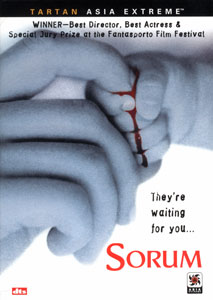Film
Index
Another theme that runs through (Peter Straub's Julia and Ghost Story)--a very Henry Jamesian theme--is the idea that ghosts, in the end, adopt the motivations and perhaps the very souls of those who behold them. If they are malevolent, their malevolence comes from us...
...What is the Ghost, after all, that it should frighten us so, but our own face? When we observe, we become like Narcissus, who was so struck by the beauty of his own reflection that he lost his life. We fear the Ghost for much the same reason we fear the Werewolf: it is the deep part of us that need not be bound by piffling Apollonian restrictions. It can walk through walls, disappear, speak in the voices of strangers. It is the Dionysian part of us...but it is still us.
--Stephen King, Danse Macabre.
The Bad Place: It used to be that a haunted house was a huge, gabled, gothic construction. We have writers like Horace Walpole and Nathaniel Hawthorne to thank for that (respectively, their books The Castle of Otranto and The House of Seven Gables are named for their real estate). So firmly built in the imagination are such houses that even as late as The Amityville Horror in 1979, we were still getting a suburban version of the haunted gothic manor. That's begun to change lately. Many writers in the genre have been experimenting with what Stephen King calls "The Bad Place," not least of whom is King himself with his haunted hotel and haunted Plymouth Fury. Lately, ghosts have been occupying more and more mundane settings. In Asia, the ghost has gone to ground in everyday objects. In a videotape, in a cel phone, in the internet. Oh, there are still traditional haunted houses--see, for instance, A Tale of Two Sisters--but like many people, ghosts have fallen on hard times. You are as likely to find them in anonymous apartment blocks with leaky plumbing as anywhere else. Such a place can be found in Sorum, one of the artier entries in the Asian ghost genre. This is a film that seems to take King at his word. There are ghosts in Sorum, and a haunted apartment, of sorts, but the ghosts in Sorum are more of a mirror held up to the id of its characters. The apartment block is what King once described as a "dressing room for werewolves."
Synopsis: The story follows Yong-hyun, a young taxi driver who takes an apartment in a dilapidated tenement. He seems like an okay sort. He has a fixation on Bruce Lee. He drives the night shift. The apartment, he is told, has a bad history. The previous tenant met with a bad end, and sure enough, there's ominous smoke damage on the ceiling. His neighbors all seem to know more than they let on about the previous tenant, but they have problems of their own. One is a shut-in writer, whose failure as a publisher has caused him to retreat into his apartment. Another is mourning her lost child. Still another is a woman in an abusive relationship. This last woman, Sun-yeong, has pleasant words for Yong-hyun, but those words lead to a violent confrontation with her husband. When she ensnares Yong-hyun in her life, this starts a long, mutually destructive relationship that sees them both drawn into a reenactment of the violent events from the past.
Horrors: On the surface, this hardly seems like a ghost story at all. Trust me: it is, though the face it puts on the ghosts will surprise viewers expecting the long-haired ghost girls of The Ring and its progeny. The film's plot most closely matches The Devil's Backbone among recent horror movies, with it's notion that ghosts are like bugs trapped in amber, repeating the same awful events over and over. The execution couldn't be more different, though. Director Yoon Jong-Chan takes a minimalist approach to things. He points his camera at his actors and his story and barely intrudes at all. There are no jump-scares in this film. The unfolding of the drama is allowed to percolate in its modernist alienation and its picture of Korean society in collapse and under siege by encroaching American consumerist culture to the point where you almost forget that you are watching what is supposed to be a horror movie. Almost. The final half-hour of the film veers very far from the miserablist trappings of the rest of the film, though not in such a way as to constitute a non-sequitur (the film doesn't "cheat" to arrive at its destination, if you will).
The filmmaking is as accomplished as anything you'll find in contemporary Korean cinema. Again, we are presented with a movie where the camera never seems to be in the wrong place, where the textures of the film are evocative and well designed. Kudos to cinematographer Hwang Seo-Sik. That all said, the "dramatic" element of the film's first two thirds can be a tough slog given a narrative with so few sympathetic characters and so many alienated longueurs. Caveat emptor, I guess.

11/26/05